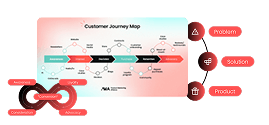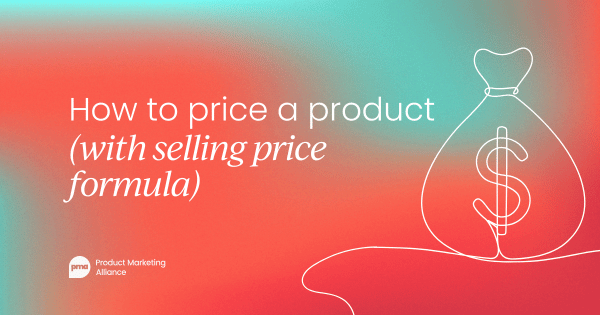Thanks for joining me for this deep dive into the world of analyst relations (AR)! Here’s a taste of what we’ll cover:
- Analysts’ vital role in the tech space
- The four steps to build your AR strategy
- How you can engage analysts throughout your GTM
- How to measure the impact of your AR strategy
- Some best practices and hard-won lessons in analyst relations
But first, let me introduce myself. I'm Andrew Keating and I currently spearhead analyst relations at Beamery. That and my past experiences in product marketing and industry marketing teams, where I worked closely with dedicated AR teams, have given me a broad perspective on analyst relations.
So, whether you're part of a team focusing on analyst relations, or you're a solo product marketer overwhelmed with launching products and wondering how to even get started with analyst relations, this article has something for you.
Let’s get into it.
What role do analysts play?
Let's take a step back and think about the role of analysts. Analysts are like brokers whose currency is trust and relationships. They bridge the gap between customers and technology providers. They’re the trusted intermediary that talks to both sides.
Now, sometimes that intermediary role can be a little frustrating for us in the software realm – we wish they were more clearly on our side. Customers can get a little frustrated with all this, too – they’re like, “Just tell me what to buy!” while analysts remain steadfastly neutral.
We may sometimes do paid engagements with analysts; they may even advise us on go-to-market strategy. They may be paid by customers to help with an RFP (request for proposal), an RFI (request for information), or a purchasing decision. However, their effectiveness hinges on maintaining objectivity and trust with both sides.
As product marketers, we need to empathize with their position and understand what success looks like for them. Their success may involve producing reports, advising clients, or gaining new business. The service they sell – advice, market trends, and perspectives – requires us to step into their shoes and understand where they’re coming from.
How to start building your AR strategy
So, how do we start building an analyst relations strategy? There are four key steps. Let’s take a look.
Step one: Define roles and responsibilities
The first step is defining roles and responsibilities. For product marketers, this means establishing a clear RACI (Responsible, Accountable, Consulted, Informed) or DESI (Driver, Executor, Support, Informed) matrix.
In organizations with a dedicated analyst relations function, whether it's a single person or a small team, they will likely be the primary drivers and executors of this strategy.
In larger, established companies, product marketing often plays a supporting and partnering role. If you're new to such a company, part of your onboarding should include meeting with the analyst relations team to understand and collaborate on the existing strategy.
In contrast, early-stage or growth-stage companies may not have dedicated analyst relations resources. In these cases, it's crucial to clarify product marketing's role in the program – who will own and define it.
You might find yourself advocating for the importance of analyst relations to leadership and taking the lead in developing a strategy. This is a golden opportunity to step up and contribute to the company's growth and direction.
Step two: Identify the key analyst firms and influencers
When building an analyst relations strategy, it's crucial to look beyond your organization. Start by identifying key analyst firms and influencers in your specific industry. This information might already exist within your organization, or you might be starting from scratch.
Let’s explore a loose categorization of the analyst firms out there. The "top tier" firms, like Gartner, Forrester, and IDC, are well-known and cover a wide range of software and products. They have something to say about nearly every software space.
If you’re selling to enterprises, you’re going to be engaging with these top-tier firms whether you like it or not, since all enterprises are talking to the likes of Gartner, Forrester, and IDC. That means you need to think about how you’re going to engage with these firms.
Then, there are the more niche firms, specializing in specific software areas or problem spaces. For example, in the HR tech space where my company operates, there are analysts focusing specifically on this sector. Identifying and engaging with firms relevant to your organization and product is essential.
These niche firms, who are deeply knowledgeable about their specific areas, are particularly valuable for smaller or growth-stage companies. While it might be tough to capture the attention of larger firms like Gartner or Forrester, if you've got a product and a pitch that resonates with a specific technology space, then the niche firms are going to want to know about it.
Another category to consider is influencers – individuals or small teams who have impact and credibility in specific areas. These might be former executives or practitioners who’ve transitioned to consulting and advising roles. They might have left their day jobs to start consulting or producing research, blog posts, and other content.
It's a great idea to start identifying the influencers who are active on LinkedIn, X (formerly known as Twitter), and other social media platforms. They can offer unique perspectives and valuable insights in your specific field.
As part of your analyst relations strategy, create an inventory of these individuals and firms to engage with, recognizing the different levels of influence and expertise they bring to the table.
Step three: Develop an engagement strategy
Once you've defined roles and responsibilities within your organization and identified the range of relevant analyst firms, the next step is to develop an effective strategy for analyst engagement.
You don’t have to reinvent the wheel here. You already have a go-to-market strategy, product marketing objectives, and upcoming launches. The key is integrating analyst engagement into these existing plans.
Start by considering how to inform and engage analysts about upcoming launches, but how can you go about this? For large top-tier firms, start by building relationships with key analysts specific to your area. Pinpoint up to five essential analysts in your space and prioritize engaging with them.
Next, set clear objectives for each analyst firm and influencer. This can be as simple as a sentence or two in your internal documents outlining your goals with, say, Gartner, for the coming quarter or fiscal year. Remember, achieving these goals may take some time – building relationships is a long-term, ongoing process.
Step four: Build strong relationships with your target analysts
To establish strong relationships with analysts, regular briefings and updates are essential, so you’ll want to develop an annual calendar for these engagements.
Top-tier firms often publish reports on a regular cadence, such as Gartner's Magic Quadrant reports. Once a report is published, use it as a cue to start planning for the next year.
Your engagement calendar should include multiple touchpoints, such as in-person meetings at trade shows or conferences, virtual briefings, or events hosted by your company.
Maintaining ongoing engagement with analysts is essentially like being in a never-ending deal cycle. For top-priority firms, aim for discussions at least every couple of months. For influencers or organizations lower on your priority list, engagement can be less frequent but no less than once or twice a year.
Sustained engagement is key to building and maintaining these valuable relationships. In strengthening our analyst relations, one key strategy is sharing company news and milestones early.
At Beamery, we're refining this approach by providing analysts with information under embargo a few days or a week before a public announcement. Of course, we have to trust analyst firms to keep that information to themselves for a while, but it’s a great way to ensure that they’re prepared with content and commentary when the news goes live.
Providing product demos is another key part of engaging analysts. Much like customers and prospects, they often want to see the product in action. It’s not enough to have presentations and discussions – when push comes to shove, they want to see what you’re talking about. This might mean conducting the demo yourself or involving a specialist, like a sales engineer, in analyst meetings.
Similarly, providing customer references is essential. Analysts want the opportunity to speak with actual users who’ve benefited from your product. This, however, poses a challenge, as you don’t want to overburden your advocates. That means you need to coordinate with your customer success and reference management teams to strike the right balance.
Ultimately, these efforts are invaluable. When analysts can directly engage with your product and hear from satisfied customers, it has a major impact on how they talk about your product, benefiting your company's visibility and reputation down the line.
Engaging analysts through your GTM
The bottom line is that you want to engage with analysts throughout your go-to-market, and you need to take a collaborative approach to do that effectively. Luckily, as a product marketer sitting at the intersection of marketing, product, sales, and customer success teams, you’re perfectly placed to do that.
As the title of this article suggests, the key to effective analyst relations lies in treating analysts as personas – similar to how we approach buyer or user personas. Spend time understanding analysts – their motivations, interests, and the questions they might have. This approach helps in tailoring your engagement strategies to meet their specific needs and interests.
And don’t forget that analysts are a goldmine for competitive and market intelligence. They interact with a range of competitors, offering a broad view of the market landscape. It's crucial to stay updated with their reports, blogs, and posts; the information you can gather from these sources is invaluable for your market and competitive intelligence work.
Involving analysts in your product launches and development stages is vital too. Most are willing to sign NDAs; this means you can meet with them and get their feedback on beta products and early-stage ideas. That way, you not only get to optimize your product, but analysts will be prepared to talk about it when it launches.
If your budget allows, you’ll also want to collaborate with analysts on thought leadership and joint research. You may also want to look into licensing existing content or reports they've produced. This varies in cost depending on the firm. The top-tier global firms tend to be the most expensive, while niche firms may be more affordable.
All this begins with setting a budget, but that's just the starting point. It's crucial to categorize which firms are most valuable for your go-to-market efforts and where third-party content will have the greatest impact. Knowing your budgetary limits is essential, but it's equally important to strategically allocate these resources.
Aligning resources involves more than just financial planning. It includes collaboration with product managers, executives, and customers. For instance, we're currently collaborating with an analyst firm on a report structured around interviews with customers. This not only provides us with valuable analyst insights but also amplifies our customer references, offering greater value than a standard report.
Ultimately, you need to keep placing yourself in the analyst's shoes, understanding their motivations, and integrating their insights into your planning and go-to-market strategies.
Measuring the impact of your AR strategy
As with any go-to-market motion or program, it's important to measure the impact of your analyst relations strategy. Ideally, you’ll pay attention to both quantitative and qualitative factors.
On the qualitative side, it’s a great idea to focus on analyst coverage and sentiment. Keeping a running document or tracker, whether that’s in a simple spreadsheet or a more sophisticated CRM system, helps monitor analysts' opinions and reactions to your products and market activities.
You’ll also want to track the influence of analysts on customer decisions. This can be done within your CRM system by documenting instances where analyst interactions have influenced customer choices, whether in winning or losing deals. Monitoring these signals helps connect analyst relations to tangible business outcomes, ensuring a comprehensive understanding of their impact on your overall strategy.
Beyond direct analyst interactions, it's important to monitor broader market perceptions. This includes tracking if and how analysts' statements about your company or product influence other market players. Keeping an eye on this ripple effect is crucial.
When evaluating ROI, the approach is similar to tracking campaigns and other marketing activities. For content developed jointly with an analyst, measure its performance just like you would for any other content piece.
If you host a joint webinar or invite an analyst to one, assess attendance ratios and attendee feedback. Essentially, it's about applying standard marketing evaluation methods but through the lens of analyst relations.
Opportunity attribution is another vital aspect to monitor, albeit a pretty complex one. A simple start is to flag opportunities in your CRM as “analyst influenced” or not. This helps gauge the extent of analyst influence on deals and opportunities. If a structured field in the CRM isn't feasible, encourage sales reps to document this influence elsewhere.
Reviewing this data periodically can reveal trends, like how many deals were influenced by a particular analyst firm or by analysts in general. This understanding is key to attributing analyst influence on your pipeline, opportunities, and wins and shaping the future of your AR program.
Tracking your placement in analyst reports is also essential. Annual reports like the Gartner Magic Quadrant offer a clear metric for year-over-year comparison.
In the past, I’ve seen teams literally take out a ruler and measure their position changes on the Magic Quadrant to assess progress. That sounds wild, but it’s important to make sure you’re continually rising in these placements and to share your progress internally through reports and discussions.
Best practices and lessons learned in analyst relations
Let’s wrap up with some best practices, hard-won lessons, and key takeaways on managing an analyst relations program:
🌟 Continually refine your AR program: At least once a year, it’s vital to take a look at what’s working and what’s not and optimize accordingly.
🤝 Bring in multiple stakeholders: Involve various teams such as product, marketing, customer success, sales, and legal to ensure a comprehensive approach.
↔️ Ensure bidirectional interaction: Foster a two-way relationship where your team assists in analyst engagement and analyst feedback informs your internal efforts.
📞 Maintain consistent communication: Keep communication lines open and consistent, adapting as market conditions and your company's offerings change.
⚠️ Avoid neglecting analyst relations: Even in small startups, it's crucial to at least consider how and when to integrate analyst relations into your strategy.
👯 If you’re lucky enough to have an AR team, make sure you collaborate with them: Don't just delegate everything to analyst relations; actively partner with them to build a cohesive strategy.
📅 Implement a structured engagement calendar: Instead of taking a scattershot approach to analyst interactions; establish a year-round engagement schedule with analysts.
💰 Beware of mismanaging budgets: Ensure that your spending on analyst relations is part of a well-defined strategy, avoiding waste on engagements with no clear goal.
🧐 Set realistic expectations for spend: Understand that spending money on a single report or engagement won't yield miraculous results; it's part of a larger strategy.
🚀 Product marketers should drive AR strategy: Whether independently or in partnership with an AR team, product marketers should lead the way, aligning internal resources effectively.
📊 Measure and track AR activities: Similar to how launches and go-to-market strategies are managed, consistently measure and track the impact of AR efforts.
🤗 Adopt a collaborative approach with analysts: View analysts as personas, understand their perspectives, and use this insight to guide your AR strategy.
This article is based on a presentation given by Andrew Keating at the Product Marketing Summit in Denver. Catch up on this presentation, and others, using our OnDemand service. For more exclusive content, visit your membership dashboard.


















 Follow us on LinkedIn
Follow us on LinkedIn




.svg)
Start the conversation
Become a member of Product Marketing Alliance to start commenting.
Sign up now